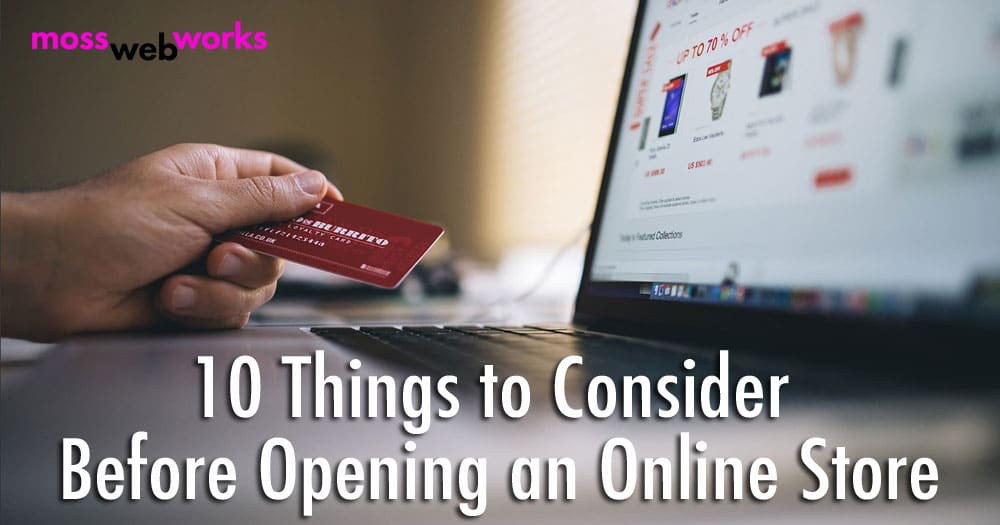I get many clients asking about opening an online store, without really knowing or understanding what is involved. Some have a fantasy of selling product and making tens-of-thousands to hundreds-of-thousands to millions of dollars each month–rarely the case. So I’ve put together this list of things to consider before you jump in and pay a developer to create a store on your website.
There are different ways to sell products online.
The simplest way to sell products is to use dedicated sites like Etsy or eBay. These are completely separate from your website, but you can link to them from your website. You can also put products on your own website and use a simple PayPal link. PayPal includes a shopping cart function, however they take out about 4% of each sale. If you have more than a few products, you might want to consider a hosted store like Shopify or BigCommerce, which let you create a subdomain like shop.yourwebsite.com. They charge you monthly for specific levels of service, process credit cards, and manage your inventory for you. You can also have a full eCommerce system completely hosted within your website. Most clients who ask about having a “store on their site” are envisioning the latter.
A well-implemented eCommerce system is not cheap.
If done correctly, you’re looking at a minimum of $5,000 (and up) to implement a full store on your website. Why? Because it takes design, setup, product entry, photos, payment integration, shipping integration, and testing. So consider your monthly sales profits as they are now, and calculate how long it will take you to recoup the development cost. Not potential sales–current sales.
But won’t an online store skyrocket my sales?
In most cases, no. If you have a healthy sales system already, an online store will augment sales. If you are moving from another online system (like Shopify or BigCommerce), a store based on your website will give you more control, design flexibility, and profit. But if you have no sales or little sales of your product offline and are counting on your online store to skyrocket sales, you will be disappointed.
But if I build it, they will come…right?
The simple answer is No. You can have the most beautiful, well-designed online store in the world, but if you don’t already have a customer base, then how will people find you? That’s where you have to have a solid marketing plan–and a healthy marketing budget–to bring in customers. Just having a website store will not bring you sales.
You must do inventory.
In order to have an online store of products, you must already have a solid inventory system. Each item should be tagged and tracked in some kind of database. You have to know how many items you have, their dimensions, and their weight. If you also have a brick-and-mortar store, you have to sync inventory between your physical store and web store. In other words, if an item is sold in-person, you must reduce the number available online. Or if it’s one of a kind, remove it from your online store.
Photos make the sale.
Product photos are everything in an online store. Are you prepared to hire a photographer to take great photos of your products? Amateur photos will deter potential customers from trusting you, and subsequently will kill sales. If you look rinky-dink, no one is going to give you their credit card information. If you are cell savvy and have some great photo and product apps, you can take your own photos. If not, then hire a professional to take your product photos, then send them off to your web developer.
How are you going to collect payment?
Do you want to take checks, credit cards, bank transfers? Do you already have a merchant account? Stripe is a service that offers payment integration with your website and they take out the standard merchant pricing: 2.9% of the total charge plus .30 per successful transaction.
Shipping is a b**ch.
The most complicated part of running an online store is shipping. You need to decide how you are going to ship the items, to where, the providers (USPS, UPS, FedEx), and shipping methods (Overnight, Ground). Do you need the system to calculate shipping or will you have flat-fee shipping? Is the shipping included in your price? Are you going to charge for handling? Materials? If you get this wrong, you can lose money on every sale.
You must collect sales tax.
Are you going to calculate sales tax or include it in your pricing? Either way, you must pay it.
SSL, Privacy Policy, Return Policy, and Terms of Service
If you are collecting any kind of user information on your website you must have a custom privacy policy and terms of service clearly posted on your website, and there must be a way for your customers must agree to both. These can be written by a legal professional, or you can use an online source that sells templates. You should already know your terms about returns, because people want to see that clearly on your website. If you don’t have a return policy clearly posted, customers who are unhappy with their purchase can create chargebacks on their credit card, which damages both your company’s credit and reputation. You must also make sure you have an SSL certificate implemented on your website. Some hosts offer free SSL with hosting, and some charge extra for it. Either way, make sure that little lock icon is enabled when people view your site.
I know this is a lot of information to process, but it’s necessary for online retailers to understand the above before you can successfully open and maintain an online store.
Now once you are prepared for the expense, marketing, and implementation, Moss Web Works is happy to help you accomplish this dream.

